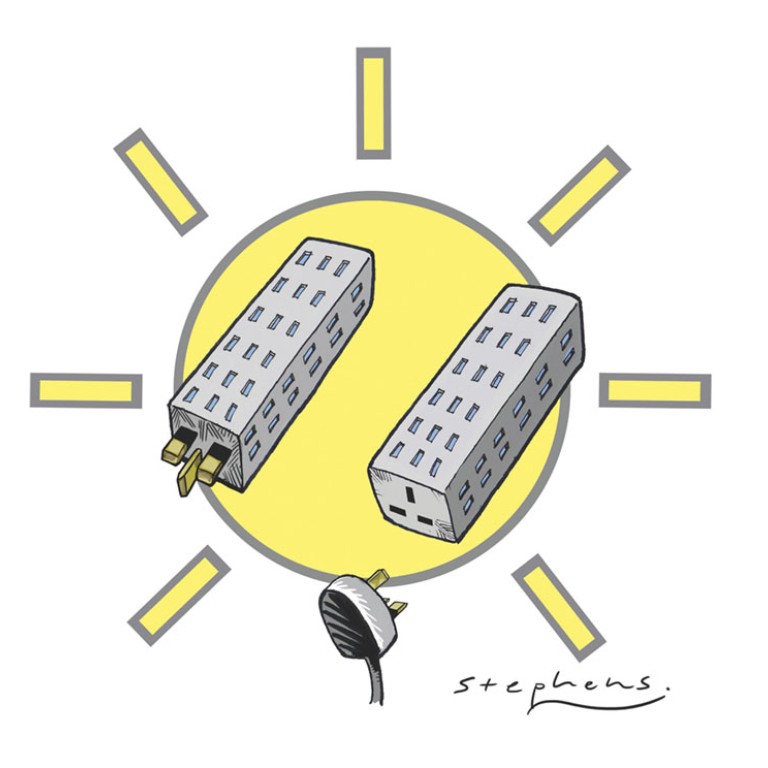
Hong Kong's buildings should be generating electricity, not using it
Ian Brownlee says tried and tested technology is available to enable Hong Kong buildings to tap our abundant solar energy for use; what's lacking is the leadership to push for change
This week is World Green Building Week, and it is observed in Hong Kong. The past approach to sustainable building design has largely focused on making buildings more energy efficient and reducing their carbon footprint. Maybe Hong Kong is now in a position to take a big positive step forward and make buildings energy producers.
With Hong Kong recording the hottest summer months ever this year, global warming seems more of a reality than ever. All of us have been affected by the heat in one way or another and I cannot help but wonder why Hong Kong doesn't make more of an effort to generate more of its energy from the sun.
Stand by any window and you can feel the heat energy coming in. Blinds come down to keep the sun out and then the air conditioner goes on and we use electric energy to cool the interior of the building. Unlike cooler climates, where energy use is highest at night for heating, our peak usage occurs during the day for cooling - when the sun is providing all of us too much "free" energy.
The solar energy business is well developed in Europe and mainland China, which are big producers of solar energy equipment. The technology is now well advanced. Throughout most places in the world, some form of solar energy generation is part of the plan to make better use of renewable energy.
Solar water-heating panels are on the roofs of many buildings in mainland China and Taiwan - multi-storey residential buildings similar to ours. Many also have solar panels which generate electricity. The technology is there, and it works.
Hong Kong tends to treat it as something not appropriate for our tall buildings, and it is not a significant feature in the government's review of future energy sources. If we are to use any renewable energy source, then solar seems the most logical choice - more so than wind.
Technology is also developing quickly that makes energy-generating windows possible. These clear windows allow light in and, at the same time, convert solar energy to electricity. Those behind the technology are developing designs suitable for glass-clad buildings, which now dominate Hong Kong.
If a building was clad in a combination of solar panels and energy-generating windows, it would become a producer of electricity, rather than just a user, as almost all of our commercial buildings are at present.
We already have many institutional and government buildings which are using solar systems to generate electricity, and the Electrical and Mechanical Services Department has helped to promote this. If it is feasible for some buildings, then why not more widely, throughout Hong Kong?
One reason is that there is no incentive for it to be done. The two electricity companies are not obliged to take electricity generated from sources outside their own generating plant.
The scheme of control agreement under which each operates also promotes the development of their own generating plant rather than to use electricity from other processes.
My own experience is that solar water heating in Hong Kong can reduce costs by about 90 per cent, with grid electricity used only for 10 per cent in the cloudy winter period. In another case, communal electricity charges for a small apartment building were reduced by about 75 per cent by using solar power generated on the roof of the building.
That was in a country where the grid was obliged to purchase the power generated from the building. We create a credit with the power company with what they buy and this is offset against our purchases. In three years, the capital cost will be recovered. With a grid connection, there is no need for expensive and environmentally unfriendly storage batteries.
It's time to change the approach in Hong Kong from minimising energy use in buildings to promoting the production of energy from buildings. Two simple steps could help. One would be to require the electricity companies to buy energy from other renewable energy sources such as solar and creating a direct financial incentive for investment.
The other is to require all curtain-wall buildings - that is, buildings with an outer covering that is non-structural, designed to keep out the weather, for example - to include solar panels and energy generating windows. Residential buildings should be required to include solar panels and solar water heating to at least meet part of the residents' needs.
In terms of our total energy usage, it may not make a significant impact, but at present Hong Kong is not making any effort to utilise our most abundant renewable source of energy. When you next look at a building shining in the sunlight, just think that it should be generating energy, reducing our power bills, reducing our reliance on other fuels and helping reduce our greenhouse gas production.

